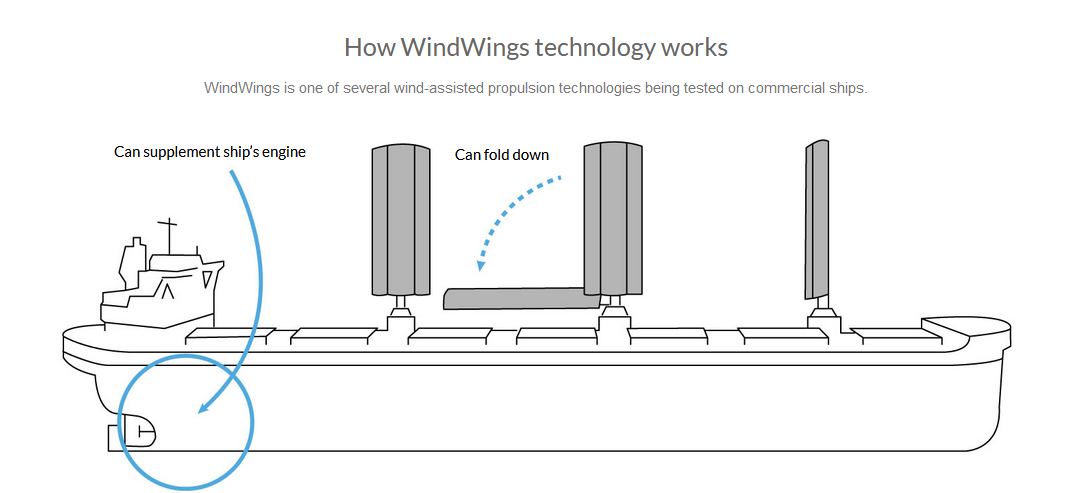04:53:19 pm 10/05/2023
Viewed: 4697
Harnessing the Winds of Change:
Revolutionizing Commercial Shipping with Wind-Assisted Propulsion Technologies
Introduction
Imagine a world where colossal cargo ships glide effortlessly across the ocean, powered by the same winds that guided ancient mariners. With innovations like WindWings, this isn't just a romantic notion—it's a sustainable reality that's taking shape right now!
The Winds of Innovation: Meet WindWings
WindWings are not your grandfather's sails; they are large, rigid structures that resemble airplane wings. Controlled by computerized sensors, these marvels of engineering adjust themselves to capture the wind's speed and direction optimally. Companies like BAR Technologies are at the forefront of this innovation, and according to their CEO, John Cooper, wind power for shipping is a "no-brainer" that can save up to 30% of fuel and emissions on certain routes.
The Economic Tailwind
But wait, there's more! Jan Dieleman, the president of Cargill’s ocean transportation business, is betting big on wind power as part of Cargill's commitment to decarbonize its supply chain. The numbers are staggering—WindWings can reduce fuel costs by up to 20%. In an industry where margins can be razor-thin, this is a game-changer. Plus, let's not forget the job creation potential in the burgeoning wind industry, which already employs over 120,000 people across the U.S.
A Renewable Revolution
Gavin Allwright, the secretary-general of the International Windship Association, reminds us that wind is a renewable and inexhaustible energy source. It's the ultimate win-win, offering a sustainable solution that aligns with global emission reduction targets. The International Maritime Organization aims to halve shipping emissions by 2050, and wind power is poised to play a pivotal role in achieving this milestone.
Community and Environmental Impact
The benefits don't stop at the dock. Wind projects generate tax revenues and land-lease payments that can uplift local communities. However, it's crucial to navigate the challenges responsibly. While wind power is generally cleaner, concerns about bird and bat fatalities, as well as visual and noise pollution, must be addressed.
Navigating Challenges
Of course, no sea change comes without its challenges. Wind power is subject to the whims of Mother Nature, and not all technologies are created equal. Different systems like Flettner rotors, wing sails, and kites each have their pros and cons. Moreover, retrofitting existing ships can be a costly endeavor, and operational adjustments may be needed to optimize wind conditions.
The Future is Wind-Powered
Palle Laursen, the chief technical officer of Maersk, sums it up best: wind power is one of the many solutions that the shipping giant is exploring to achieve its goal of net-zero emissions by 2050. The winds of change are blowing, and they're filling the sails of a more sustainable and economically viable maritime industry.
Conclusion
So there you have it, folks! The age of wind-powered commercial shipping is not on the distant horizon—it's here, and it's spectacular. As we continue to innovate and overcome challenges, the promise of a cleaner, more efficient, and more sustainable shipping industry becomes increasingly attainable.
Ready to embark on this exciting voyage? Share your thoughts in the comments below, and let's keep this conversation sailing!
Revolutionizing Commercial Shipping with Wind-Assisted Propulsion Technologies
Introduction
Imagine a world where colossal cargo ships glide effortlessly across the ocean, powered by the same winds that guided ancient mariners. With innovations like WindWings, this isn't just a romantic notion—it's a sustainable reality that's taking shape right now!
The Winds of Innovation: Meet WindWings
WindWings are not your grandfather's sails; they are large, rigid structures that resemble airplane wings. Controlled by computerized sensors, these marvels of engineering adjust themselves to capture the wind's speed and direction optimally. Companies like BAR Technologies are at the forefront of this innovation, and according to their CEO, John Cooper, wind power for shipping is a "no-brainer" that can save up to 30% of fuel and emissions on certain routes.
The Economic Tailwind
But wait, there's more! Jan Dieleman, the president of Cargill’s ocean transportation business, is betting big on wind power as part of Cargill's commitment to decarbonize its supply chain. The numbers are staggering—WindWings can reduce fuel costs by up to 20%. In an industry where margins can be razor-thin, this is a game-changer. Plus, let's not forget the job creation potential in the burgeoning wind industry, which already employs over 120,000 people across the U.S.
A Renewable Revolution
Gavin Allwright, the secretary-general of the International Windship Association, reminds us that wind is a renewable and inexhaustible energy source. It's the ultimate win-win, offering a sustainable solution that aligns with global emission reduction targets. The International Maritime Organization aims to halve shipping emissions by 2050, and wind power is poised to play a pivotal role in achieving this milestone.
Community and Environmental Impact
The benefits don't stop at the dock. Wind projects generate tax revenues and land-lease payments that can uplift local communities. However, it's crucial to navigate the challenges responsibly. While wind power is generally cleaner, concerns about bird and bat fatalities, as well as visual and noise pollution, must be addressed.
Navigating Challenges
Of course, no sea change comes without its challenges. Wind power is subject to the whims of Mother Nature, and not all technologies are created equal. Different systems like Flettner rotors, wing sails, and kites each have their pros and cons. Moreover, retrofitting existing ships can be a costly endeavor, and operational adjustments may be needed to optimize wind conditions.
The Future is Wind-Powered
Palle Laursen, the chief technical officer of Maersk, sums it up best: wind power is one of the many solutions that the shipping giant is exploring to achieve its goal of net-zero emissions by 2050. The winds of change are blowing, and they're filling the sails of a more sustainable and economically viable maritime industry.
Conclusion
So there you have it, folks! The age of wind-powered commercial shipping is not on the distant horizon—it's here, and it's spectacular. As we continue to innovate and overcome challenges, the promise of a cleaner, more efficient, and more sustainable shipping industry becomes increasingly attainable.
Ready to embark on this exciting voyage? Share your thoughts in the comments below, and let's keep this conversation sailing!
No video exists.





Comments